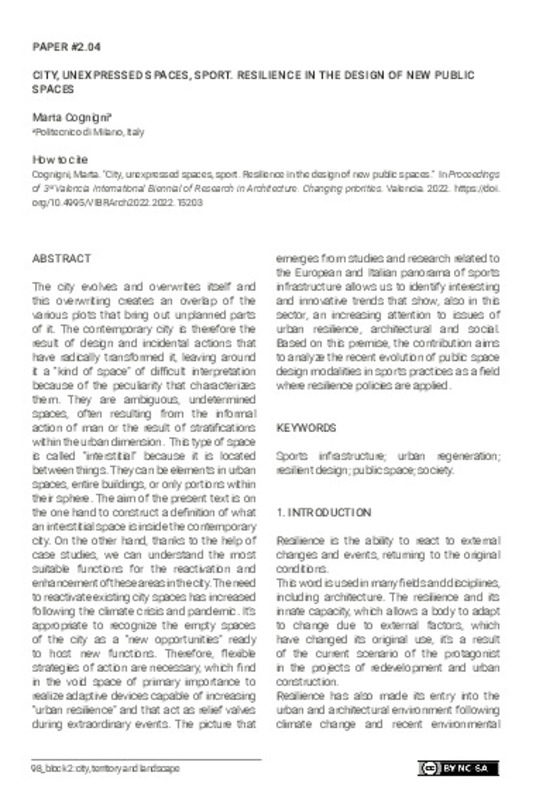JavaScript is disabled for your browser. Some features of this site may not work without it.
Buscar en RiuNet
Listar
Mi cuenta
Estadísticas
Ayuda RiuNet
Admin. UPV
City, unexpressed spaces, sport. Resilience in the design of new public spaces
Mostrar el registro sencillo del ítem
Ficheros en el ítem
| dc.contributor.author | Cognigni, Marta
|
es_ES |
| dc.date.accessioned | 2023-12-20T13:59:17Z | |
| dc.date.available | 2023-12-20T13:59:17Z | |
| dc.date.issued | 2023-05-22 | |
| dc.identifier.isbn | 9788413960265 | |
| dc.identifier.uri | http://hdl.handle.net/10251/200978 | |
| dc.description.abstract | [EN] The city evolves and overwrites itself and this overwriting creates an overlap of the various plots that bring out unplanned parts of it. The contemporary city is therefore the result of design and incidental actions that have radically transformed it, leaving around it a “kind of space” of difficult interpretation because of the peculiarity that characterizes them. They are ambiguous, undetermined spaces, often resulting from the informal action of man or the result of stratifications within the urban dimension. This type of space is called “interstitial” because it is located between things. They can be elements in urban spaces, entire buildings, or only portions within their sphere. The aim of the present text is on the one hand to construct a definition of what an interstitial space is inside the contemporary city. On the other hand, thanks to the help of case studies, we can understand the most suitable functions for the reactivation and enhancement of these areas in the city. The need to reactivate existing city spaces has increased following the climate crisis and pandemic. It’s appropriate to recognize the empty spaces of the city as a “new opportunities” ready to host new functions. Therefore, flexible strategies of action are necessary, which find in the void space of primary importance to realize adaptive devices capable of increasing “urban resilience” and that act as relief valves during extraordinary events. The picture that emerges from studies and research related to the European and Italian panorama of sports infrastructure allows us to identify interesting and innovative trends that show, also in this sector, an increasing attention to issues of urban resilience, architectural and social. Based on this premise, the contribution aims to analyze the recent evolution of public space design modalities in sports practices as a field where resilience policies are applied. | es_ES |
| dc.format.extent | 10 | es_ES |
| dc.language | Inglés | es_ES |
| dc.publisher | Editorial Universitat Politècnica de València | es_ES |
| dc.relation.ispartof | Proceedings - 3rd Valencia International Biennial of Research in Architecture, VIBRArch | |
| dc.rights | Reconocimiento - No comercial - Compartir igual (by-nc-sa) | es_ES |
| dc.subject | Sports infrastructure | es_ES |
| dc.subject | Urban regeneration | es_ES |
| dc.subject | Resilient design | es_ES |
| dc.subject | Public space | es_ES |
| dc.subject | Society | es_ES |
| dc.title | City, unexpressed spaces, sport. Resilience in the design of new public spaces | es_ES |
| dc.type | Capítulo de libro | es_ES |
| dc.type | Comunicación en congreso | es_ES |
| dc.identifier.doi | 10.4995/VIBRArch2022.2022.15203 | |
| dc.rights.accessRights | Abierto | es_ES |
| dc.description.bibliographicCitation | Cognigni, M. (2023). City, unexpressed spaces, sport. Resilience in the design of new public spaces. Editorial Universitat Politècnica de València. 98-107. https://doi.org/10.4995/VIBRArch2022.2022.15203 | es_ES |
| dc.description.accrualMethod | OCS | es_ES |
| dc.relation.conferencename | 3rd Valencia International Biennial of Research in Architecture, VIBRArch | es_ES |
| dc.relation.conferencedate | Noviembre 09-11, 2022 | es_ES |
| dc.relation.conferenceplace | Valencia, España | es_ES |
| dc.relation.publisherversion | http://ocs.editorial.upv.es/index.php/VIBRArch/VIBRArch2022/paper/view/15203 | es_ES |
| dc.description.upvformatpinicio | 98 | es_ES |
| dc.description.upvformatpfin | 107 | es_ES |
| dc.type.version | info:eu-repo/semantics/publishedVersion | es_ES |
| dc.relation.pasarela | OCS\15203 | es_ES |








